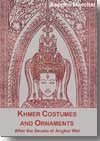| Our Publications | ||
| Books by Title | ||
| Books by Author | ||
| Books by Country | ||
| E-books | ||
| About | ||
| Orchid Press E-books | ||
| Distributed E-books | ||
| Our Bookshop | ||
| About Us | ||
| Browse Shop | ||
| How to Buy | ||
| Contact Us | ||
| WE BUY BOOKS AND LIBRARIES | ||
|
||
Book Reviews

Khmer Costumes and Ornaments:
After the Devata of Angkor Wat
bySappho Marchal
(translated from the French by Merrily Hansen)First English edition Orchid Press 2005. (1st French edition, 1927) 128 pp., 44 b & w pl., including numerous line drawings, 21.5 x 15.2 cm., softcover.
ISBN-10: 974-524-057-5 $16.00
ISBN-13: 978-974-524-057-5
Book Review by Andy Brouwer from (Cambodia Book Reviews)
Published in June 2005, Khmer Costumes and Ornaments is an important translation into English by Merrily Hansen, that brings the painstaking analysis of the unique apsaras of Angkor Wat by Sappho Marchal to a wider audience of present-day scholars and visitors to Cambodia.
Hansen’s preface explains; ‘During a brief one-week stay in the Angkor Park area, I felt overwhelmed by the complexity and unfamiliarity of the images that blanketed every surface—there was simply too much to absorb or understand. One clear impression that remained, was that of the hundreds and hundreds of celestial nymphs, commonly called apsaras, which are sculpted on the walls and towers of Angkor Wat. Unlike the hieratic and rigid formalism that typically characterizes the free-standing sculpture of the Angkor period, these lithe, sensuous, and animated figures, termed devatas by Marchal, appear like sentient beings only waiting for the god-king’s signal to resume their life in the courtyards of Vishnu. On first glance these heavenly figures seem almost identical, whilst on closer inspection myriad differences in their jewellery, headdresses, coiffures and costumes emerge. With the exception of several pairs of identical twins, the devatas arranged singly or intertwined in pairs of two, three, or even more, delight the viewer’s eye with their individuality. Marchal ably captures these differences in her meticulously rendered pen and ink drawings included in the 41 separate annotated plates.’
Merrily Hansen explained further to HOTP, “Sappho Marchal was Henri Marchal’s daughter. She’s now deceased; she was born in 1904 in France and came to Cambodia in 1905 with her parents. She grew up in the shadow of the temples and published this book in 1927 when she was just twenty-three years old. What’s wonderful about it is the 41 plates of pen and ink drawings that she drew to illustrate the fabulous headdresses and costumes of the 1,860 apsaras (she calls them devatas) at Angkor Wat. The book consists of an introduction that presents a general discussion of ornaments, headdresses, and garments worn by the devatas, and then it is followed by these 41 plates of pen and ink drawings with a detailed commentary. Great news is that it’s been reproduced on a wonderful heavy weight paper which will make it seem like the original, which was a gorgeous letter press printed book. Chris Frape, the publisher of Orchid Press has also pledged to give some of the profits to the German Apsara Conservation Project (GACP) as they were absolutely wonderful to me during my visit last year. I spent a day with them climbing about on the scaffolding at Angkor Wat over the third level on the west side as well as the north gopura which they had just started to repair, so I really got a feeling for the incredible behind-the-scenes conservation efforts that are ongoing at Angkor Wat.”
For those interested in these majestic creations, the publication of this translation is all the more precious and timely since many of the original reliefs have severely deteriorated or disappeared due to erosion and weathering of the sandstone. Let’s hope the conservation efforts underway will protect these fabulously meticulous carvings for future generations. Khmer Costumes and Ornaments is published in Bangkok by Orchid Press and is a valuable contribution to the art and architecture of Cambodia’s priceless treasures.
[Read a review from www.devata.org] [Read a review from the Journal of the Siam Society] [Read a review from The Nation] [Read a review from Amazon.com] [More Orchid Press Reviews]
PO Box 70, Trinity TB, NL, A0C 2S0, Canada
Telephone: +1 709-330-4703